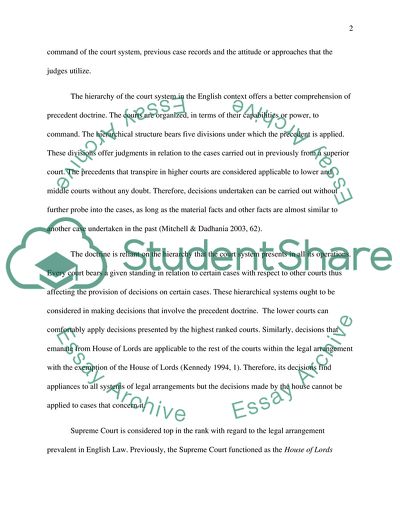Cite this document
(The Doctrine of Judicial Precedent Essay Example | Topics and Well Written Essays - 2000 words, n.d.)
The Doctrine of Judicial Precedent Essay Example | Topics and Well Written Essays - 2000 words. https://studentshare.org/law/1769515-the-doctrine-of-judicial-precedent-depends-on-the-hierarchy-of-the-courts-the-written-records-of-cases-and-the-approach-of-the-judges-asses-the-relative-importance-of-these-three-elements
The Doctrine of Judicial Precedent Essay Example | Topics and Well Written Essays - 2000 words. https://studentshare.org/law/1769515-the-doctrine-of-judicial-precedent-depends-on-the-hierarchy-of-the-courts-the-written-records-of-cases-and-the-approach-of-the-judges-asses-the-relative-importance-of-these-three-elements
(The Doctrine of Judicial Precedent Essay Example | Topics and Well Written Essays - 2000 Words)
The Doctrine of Judicial Precedent Essay Example | Topics and Well Written Essays - 2000 Words. https://studentshare.org/law/1769515-the-doctrine-of-judicial-precedent-depends-on-the-hierarchy-of-the-courts-the-written-records-of-cases-and-the-approach-of-the-judges-asses-the-relative-importance-of-these-three-elements.
The Doctrine of Judicial Precedent Essay Example | Topics and Well Written Essays - 2000 Words. https://studentshare.org/law/1769515-the-doctrine-of-judicial-precedent-depends-on-the-hierarchy-of-the-courts-the-written-records-of-cases-and-the-approach-of-the-judges-asses-the-relative-importance-of-these-three-elements.
“The Doctrine of Judicial Precedent Essay Example | Topics and Well Written Essays - 2000 Words”. https://studentshare.org/law/1769515-the-doctrine-of-judicial-precedent-depends-on-the-hierarchy-of-the-courts-the-written-records-of-cases-and-the-approach-of-the-judges-asses-the-relative-importance-of-these-three-elements.


